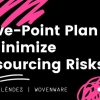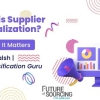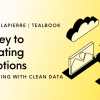Make Putting a COAT on Your Data a Top Priority
Can you imagine standing in the middle of a snow blizzard without a COAT on? No… me either. It doesn’t sound like a particularly fun way to spend an evening and let’s face it, no one wants to be exposed to the elements. But guess what? Your data is the same. Think about all the consequences for your health if you were to be stuck out in freezing, stormy weather without a layer of protection on: snotty nose, shivering or, even worse, hypothermia and frostbite.
Your data is the same—without a COAT it will succumb to exposure from the elements. It could affect the business performance, financial situation, risk jobs or even the fate of the company. This is more important than ever as businesses face even more interruptions and obstacles in the wake of the pandemic.
This is why for 2021 my message is simple: your top priority for 2021 is putting a COAT on your data.
So, what does a data COAT look like? Well…
It’s Consistent
Generally, data is used by many people or teams, which can lead to multiple classifications of one product. For example, one person might put DHL as a “courier,” while another might log it as “logistics” or “warehousing.” A taxi might be classified generically as “travel” when it should be classed as “Travel > Road Transport > Taxis” and a project cost should be assigned to the same budget or GL code, not several.
Or it could even be a simple as units of measurement. One person may use “Liter,” another “Ltr” and another “L” – but these should all be one format. This means everything can be reported accurately, you get a true picture of what’s going on and better business decisions can be made.
It’s Organised
Data is only useful if it’s organised. Think of a messy closet and you’re looking for your favourite top but can't find it as everything has just been thrown in there. Much like your closest, you can organize your data in different ways, depending on what you want to get out of it, and that will produce different reports/analytics.
You may want to assign data to employees, teams, departments, functions or internal categories, as well as time periods such as months and quarters, or year groups like P1, P2, etc… So, for example, when you need the information on the accounts that Sharon in Finance is working on, or the sales teams’ performance for the quarter, you can pull that information quickly.
It’s Accurate
This can mean different things to different people. At its most basic level, accurate data is correct. In more detail, this could be no duplicate information; correct invoice descriptions; correct classifications; no missing product codes; standard units of measure (e.g., ltr, l, liters); no currency issues; correctly spelled vendors; fully classified data; or the right data in the right columns.
So, what does this mean? It means greater visibility across your business in several areas, allowing better decisions, as well as time and cost savings and increased profits.
It’s Trustworthy
This is critical. Business decisions around jobs, staffing, budgets, cost savings and more are all based on data. Data is used by everyone from the bottom to the top of an organization. You have to be able to trust that what you’re looking at is the right information, and you need it to be accurate in order for your teams to use the data in their daily jobs.
If they don’t trust the data, then they might not use the fancy new expensive software you’ve just spent tens of thousands of dollars installing. Or the new AI you’ve installed may not produce the right results because it’s learning from dirty data.
Now, it’s not a quick and simple process. Good classification can take hours, maybe even weeks, but it’s worth the wait when you get back your brand new, shiny data set with all your new and organized information.
It’s as simple as this: you wouldn’t risk your wellbeing by going out in sub-zero temperatures without your COAT (and probably several other layers too) and you shouldn’t work with data or make business decisions without the same level of quality data.









